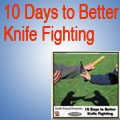Your attacker thrusts with his knife -- right at your midsection.
What do you do?
Well, if you read the last report, you now know exactly what to do, if it were an emergency situation. In other words, if the attacker were to catch you off guard, and you didn't have time to respond with anything "better."
You'd pop the wrist holding the knife, right?
Before we talk about the direction of your wrist pop, let's examine some potential dangers:
Without having you in an actual class of mine, the best two-minute advice that I can give is to make sure you combine that wrist check (pop) with a simultaneous attack of your own, a la Bruce Lee. I mentioned this in the previous report.
Also, make sure your attacker is really committed with that thrust. Use whatever it takes -- use your own feint, but make sure you aren't in slicing range for someone who also slashes before he checks.
When practicing, make sure your partner makes fast, solid thrusts at you with the knife. And practice against several partners, while you're at it. They will all come in with slightly different distances. You'll learn to gauge your distance more accurately.
Now that you have taken care of those little snafus, let's deal with an equally important issue:
Can't you just use a standard, low arm block found in so many styles?
After all, you are taught to block up, to either side, and down. Wouldn't a low block take care of a thrust coming up at a slight angle towards your stomach?
It's not the same. It has to do with the direction of the block. When you pop the wrist with the palm, the direction of your pop is downward or slightly in toward the attacker's centerline.
It is a short, quick pop. If done correctly, the attacker can't pull the knife back (with a twist of the blade if it's single edged) and slice your checking hand or wrist.
With a low block, you have all sorts of problems. The two main ones are:
My advice is to practice, so your attacker can't redirect his thrust. Stop the first thrust, while you are at the same time attacking with something else.
Better yet. Stop your attacker at a distance. Throw things -- use your legs. Play it as safe as you possibly can.
If you can't play it safe -- Pop That Wrist!
 Martial artists who think that they can use their regular moves from their styles in a knife fight, just won't have a chance.
I am not trying to be mean, just honest.
Knife against knife is a whole different kettle of fish from an empty-hand attack. You need an efficient, automatic way to respond. Here's the answer ...
Read More about 10 Days to Better Knife Fighting ...
Martial artists who think that they can use their regular moves from their styles in a knife fight, just won't have a chance.
I am not trying to be mean, just honest.
Knife against knife is a whole different kettle of fish from an empty-hand attack. You need an efficient, automatic way to respond. Here's the answer ...
Read More about 10 Days to Better Knife Fighting ...
FREE
Martial Arts
Mastery
Weekly ezine